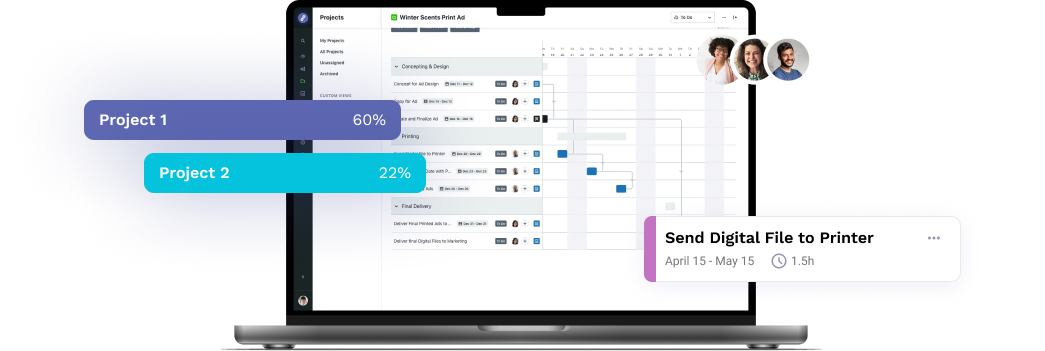
What Do We Mean by Stakeholder Communication?
You can define stakeholder communication as the sum of exchanges between the people involved in a particular business, project, or any other activity or organization that requires collaboration through clear communication.
An Example of Stakeholder Communication Issues
Picture this – it is a typical Wednesday morning. You have just received another email from a stakeholder who wants to know the status of their creative project. On top of that, they are wondering if there is any way you can deliver their collateral by Friday. Meanwhile, you know your creative team is struggling to keep up with the ever-increasing demand for content. You have already touched base with them on behalf of this stakeholder several times. You know they are making substantial progress. Still, there is no way they can complete this project by Friday.
As a project manager, you want to add value to the creative process. Yet too often, you may feel like you are spinning your wheels while keeping track of endless details. At the same time, there is constant interference between marketers and other departments. If that is your case, then you should consider making changes.
Good news! You have the power to make improvements to your process that will give your stakeholders a just-right, strategically focused result in less time. What is more, you can do so while simultaneously improving the morale and productivity of your creative team.
It all comes down to communication.
Recommended reading: Understanding Your Communication Style
Communicate Strategically to Reach Alignment at Project Kickoff
All creative teams have some process for gathering information. For example, a request intake form might ask stakeholders to check boxes for the types of collateral they need. Need a video? Complete this section of the form. Want a large banner? Tell us when you need it and for what purpose.
This information gathering is important and necessary, but true communication relies on deeper conversations. Effective, two-way communication leads to alignment between stakeholders and creatives. This in turn empowers your marketing team to achieve more.
The following guidelines will help you align better:
1. Understand Your Stakeholder’s Strategic Business Goals
Kick off your engagement by having stakeholders complete a creative brief that thoroughly lays out their business objectives and serves as a guide for the creative team.
Stakeholders may not have thought of their project all the way through from a big-picture perspective. The creative brief should answer questions like:
- What is the vision for and purpose of this project?
- What are the goals you are trying to reach through this piece?
- How does this collateral fit in with other projects you are currently working on?
- Have you defined what a successful outcome looks like? If so, how will you measure success?
- Who is your intended audience?
- Have you created anything like this before? Is there anything we should know about how that went?
- How quickly are you expecting to receive a final product?
Help your stakeholders clearly define their needs and expectations at the onset. Remember, they do not know everything – and they also do not know what you need to know! Proactively draw out the information you need.
2. Establish Realistic Expectations
Just like you need information from stakeholders, stakeholders appreciate having a clear sense of what to expect from your creative team. Use the kickoff meeting to provide an overview of your creative process and set realistic workflows and deadlines. Then, educate stakeholders on their role, in reviewing proofs, and how to give feedback.
If you are using a robust workflow management system, this is the time to train your stakeholders on how to use the system and provide them with access to their project, so they can track progress as needed.
3. Evaluate Ongoing Project Requests Before They Reach the Creative Team
Sometimes, clear communication begins with a simple yes or no. That is why it is important to evaluate ongoing project requests before they are assigned. Whether you are the one to review each submission, or whether you appoint someone else to serve as a “traffic manager,” someone needs to vet requests to determine if they are feasible, reasonable, and well-defined.
This sounds like an easy decision, but most workflow management software skips this step and go straight to assignment. This can lead to wasted time and added frustration for your creative team. Especially when the request submitted is not worth their limited time.
4. Keep Stakeholders Informed throughout the Creative Process
When a project is underway, you are likely to face two extremes. Stakeholders will either ask you for constant progress reports and updates, or you will have to chase them down to obtain the answers or feedback your creative team needs to keep the project on track.
Obviously neither is ideal, but you can achieve balance by providing stakeholders with an appropriate level of access to your team’s creative process. For example, you can create a virtual Kanban board that gives others a visual overview of live statuses for each piece of the project.
For the stakeholders you are always tracking down, set automated reminders within your workflow management system to alert them when they are behind on their part of the process.
A flexible and scalable workflow management system can keep stakeholders engaged while also protecting creatives from receiving too much input or oversight (you do not want stakeholders weighing in on early drafts, for instance). Software features such as defined roles, review tiers, and levels of access give stakeholders right-timed, need-to-know information and free you to focus on keeping the project moving forward rather than answering endless status requests.
5. Stop Stakeholder Communication Loops with Review + Approval
By communicating well, your team can create high-quality work that is strategic and meets expectations. However, that does not mean the proof will immediately be approved with no changes. Therefore, it is important to ask for thoughtful, actionable feedback that moves beyond a simple “love it” or “hate it” response.
To make this part of the process efficient and effective, use a workflow software that eliminates the need for back-and-forth feedback via email or Slack. Good software should offer the ability to react to a proof directly on the asset. For instance, if reviewing a video, stakeholders should be able to timestamp the exact 30 seconds they want to alter. Likewise, when evaluating messaging, they should be free to comment, edit, highlight, and move paragraphs around quickly and easily.
This direct, clear, tangible feedback will enable creative teams to deliver a result that meets your stakeholder’s overarching objectives – and because they have had the opportunity to provide valuable feedback throughout the process, there will be fewer misfires along the way.
6. Get Stakeholder Communication-Driven Results
Successful, impactful creative projects start with you. As a project manager, you have the responsibility and opportunity to create processes and workflows that effectively serve all the players involved. It begins with communication, leads to alignment around the strategic objectives and goals your stakeholders are trying to reach, and ends with tangible results.
Are you interested in creative operations software that will provide you with the support needed to transition to a more agile project management style? Lytho helps you streamline your entire workflow and harmonize all brand collateral under a single, uniform platform. Feel free to reach out to us by scheduling a demo and learning how our creative solutions can boost the effectiveness of your creative projects. We look forward to speaking with you!
Do you want to give yourself and your creative team more room for creative stimulation by automating the boring stuff? Lytho helps you streamline your entire workflow and harmonize all brand collateral under a single, uniform platform. Feel free to reach out to us by scheduling a demo and learning how our creative solutions can boost the effectiveness of your creative projects. We look forward to speaking with you!

Ready to simplify your creative operations and start having a little fun at work again? Schedule time to talk with us.
Let us show you how Lytho’s Creative Operations Platform helps in-house creative and marketing teams do better work, ease the stakeholder experience, and stay on brand.
Schedule a Demo